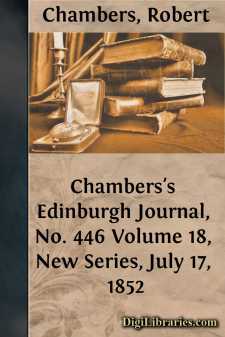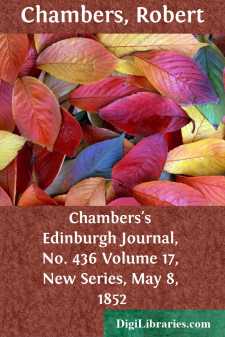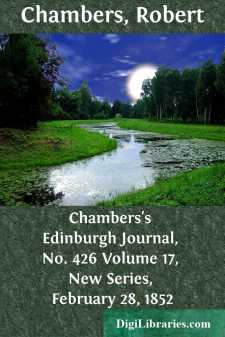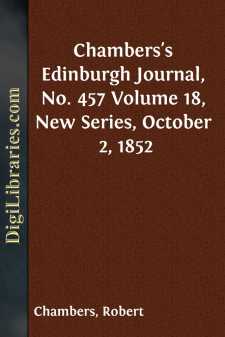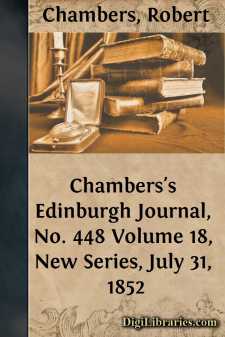Categories
- Antiques & Collectibles 13
- Architecture 36
- Art 48
- Bibles 22
- Biography & Autobiography 813
- Body, Mind & Spirit 142
- Business & Economics 28
- Children's Books 17
- Children's Fiction 14
- Computers 4
- Cooking 94
- Crafts & Hobbies 4
- Drama 346
- Education 46
- Family & Relationships 57
- Fiction 11829
- Games 19
- Gardening 17
- Health & Fitness 34
- History 1377
- House & Home 1
- Humor 147
- Juvenile Fiction 1873
- Juvenile Nonfiction 202
- Language Arts & Disciplines 88
- Law 16
- Literary Collections 686
- Literary Criticism 179
- Mathematics 13
- Medical 41
- Music 40
- Nature 179
- Non-Classifiable 1768
- Performing Arts 7
- Periodicals 1453
- Philosophy 64
- Photography 2
- Poetry 896
- Political Science 203
- Psychology 42
- Reference 154
- Religion 513
- Science 126
- Self-Help 84
- Social Science 81
- Sports & Recreation 34
- Study Aids 3
- Technology & Engineering 59
- Transportation 23
- Travel 463
- True Crime 29
Chambers's Edinburgh Journal, No. 446 Volume 18, New Series, July 17, 1852
by: Robert Chambers
Description:
Excerpt
WOLF-CHILDREN.
It is a pity that the present age is so completely absorbed in materialities, at a time when the facilities are so singularly great for a philosophy which would inquire into the constitution of our moral nature. In the North Pacific, we are in contact with tribes of savages ripening, sensibly to the eye, into civilised communities; and we are able to watch the change as dispassionately as if we were in our studies examining the wonders of the minute creation through a microscope. In America, we have before us a living model, blind, mute, deaf, and without the sense of smell; communicating with the external world by the sense of touch alone; yet endowed with a rare intelligence, which permits us to see, through the fourfold veil that shrouds her, the original germs of the human character. Nearer home, we have been from time to time attracted and astonished by the spectacle of children, born of European parents, emerging from forests where they had been lost for a series of years, fallen back, not into the moral condition of savages, but of wild beasts, with the sentiments and even the instincts of their kind obliterated for ever. And now we have several cases before us, occurring in India, of the same lapses from humanity, involving circumstances curious in themselves, but more important than curious, as throwing a strange light upon what before was an impenetrable mystery. It is to these we mean to direct our attention on the present occasion; but before doing so, it will be well just to glance at the natural history of the wild children of Europe.
The most remarkable specimen, and the best type of the class, was found in the year 1725, in a wood in Hanover. With the appearance of a human being—of a boy about thirteen years of age—he was in every respect a wild animal, walking on all-fours, feeding on grass and moss, and lodging in trees. When captured, he exhibited a strong repugnance to clothing; he could not be induced to lie on a bed, frequently tearing the clothes to express his indignation; and in the absence of his customary lair among the boughs of a tree, he crouched in a corner of the room to sleep. Raw food he devoured with relish, more especially cabbage-leaves and other vegetables, but turned away from the sophistications of cookery. He had no articulate language, expressing his emotions only by the sounds emitted by various animals. Although only five feet three inches, he was remarkably strong; he never exhibited any interest in the female sex; and even in his old age—for he was supposed to be seventy-three when he died—it was only in external manners he had advanced from the character of a wild beast to that of a good-tempered savage, for he was still without consciousness of the Great Spirit.
In other children that were caught subsequently to Peter, for that was the name they gave him, the same character was observable, although with considerable modifications. One of them, a young girl of twelve or thirteen, was not merely without sympathy for persons of the male sex, but she held them all her life in great abhorrence....


